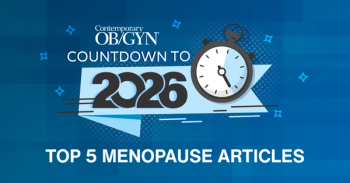
Desvenlafaxine Effectively Reduces Moderate to Severe Hot Flashes
In clinical trials, 12 weeks of desvenlafaxine effectively treated moderate to severe hot flashes in postmenopausal women, and the benefit remained after 1 year of maintenance treatment.
In clinical trials, 12 weeks of desvenlafaxine effectively treated moderate to severe hot flashes in postmenopausal women, and the benefit remained after 1 year of maintenance treatment.1,2 Desvenlafaxine, a selective serotonin and norepinephrine reuptake inhibitor, is typically used for the treatment of major depressive disorder.3
The 365 study participants-all postmenopausal women who experienced a minimum of 50 episodes of vasomotor symptoms per week-were randomized to received either placebo (n = 181) or desvenlafaxine (n = 184), with assessment of the number and severity of hot flashes at 4 and 12 weeks for the substudy and at at weeks 12, 26, and 52 for the maintenance trial.1,2 The results of the substudy showed that desvenlafaxine, 100 mg/d, can significantly reduce both the frequency and severity of moderate to severe hot flashes.1 In addition, the minimal clinically important difference (MCID) in the number of hot flashes on week 12 was a reduction of 5.35 per day, which was achieved by significantly more women in the desvenlafaxine group than in the placebo group (64% vs 41%, respectively; P < 0.001).1
At baseline, the mean frequency of moderate to severe hot flashes was 12 per day and the mean severity score was 2.4.2 By week 12, the number of moderate to severe hot flashes per day was reduced by an average of 7.47 in the desvenlafaxine group and by an average of 4.99 in the placebo group (P < 0.001). By week 52, women in the desvenlafaxine group experienced an average of 7.70 fewer moderate to severe hot flashes per day than they did at study baseline; those in the placebo group experienced an average of 4.84 fewer hot flashes per day (P < 0.001). In addition, desvenlafaxine significantly reduced the mean severity score by 0.75 at week 52.
The desvenlafaxine group also had significantly greater reductions than the placebo group in the Greene Climacteric total score at 3, 6, and 12 months (P < 0.001).2 For the 1-year study period, treatment-emergent adverse event rates were 84% for the desvenlafaxine group and 79% for the placebo group (P < 0.006). Specific adverse events were not reported in the study abstract. However, the adverse events most commonly associated with the use of desvenlafaxine include nausea, dizziness, insomnia, hyperhidrosis, constipation, somnolence, decreased appetite, and anxiety.3
Pertinent Points:
- Postmenopausal women with frequent (50 or more per week) moderate to severe hot flashes can achieve rapid symptom reduction with desvenlafaxine.
- Maintenance therapy with desvenlafaxine for 1 year effectively and significantly reduces the number and severity of moderate to severe hot flashes in postmenopausal women.
References:
1. Pinkerton JV, Constantine G, Hwang E, Chang RG, for the Study 3353 Investigators. Desvenlafaxine compared with placebo for treatment of menopausal vasomotor symptoms: a 12-week, multicenter, parallel-group, randomized, double-blind, placebo-controlled efficacy trial. Menopause. 2013;20:28-37.
2. Pinkerton JV, Archer DF, Guico-Pabia CJ, et al. Maintenance of the efficacy of desvenlafaxine in menopausal vasomotor symptoms: a 1-year randomized controlled trial. Menopause. 2013;20:38-46.
3. Pristiq [prescribing information]. New York: Pfizer Inc; 2011.
Newsletter
Get the latest clinical updates, case studies, and expert commentary in obstetric and gynecologic care. Sign up now to stay informed.




